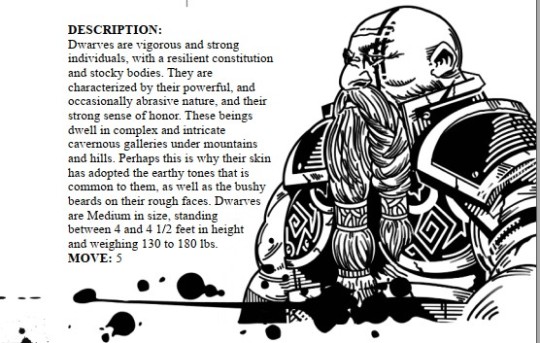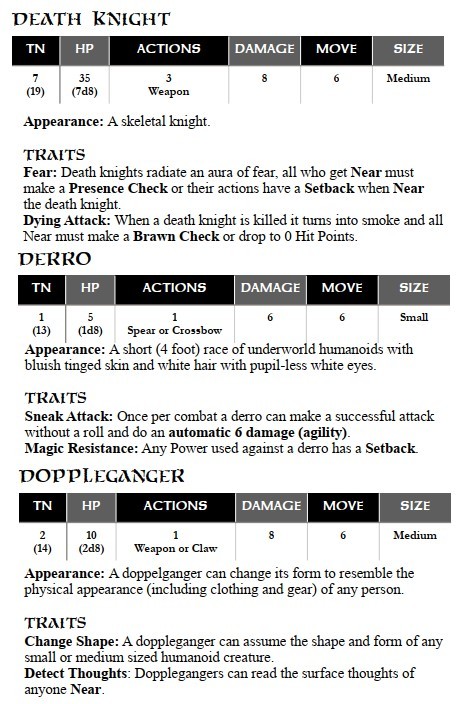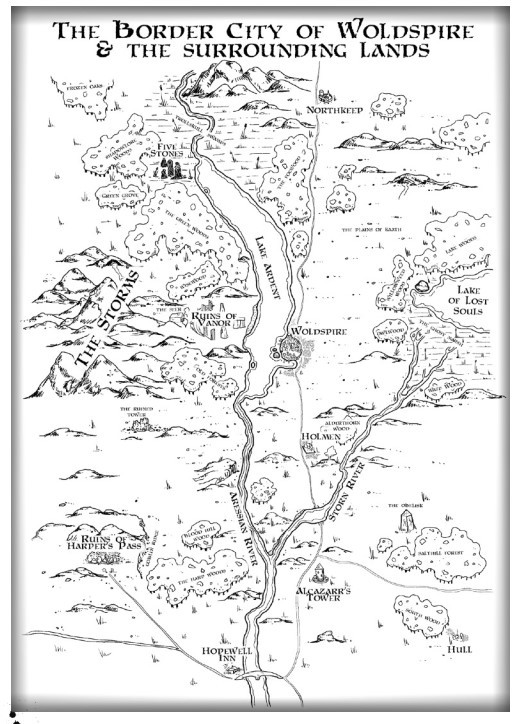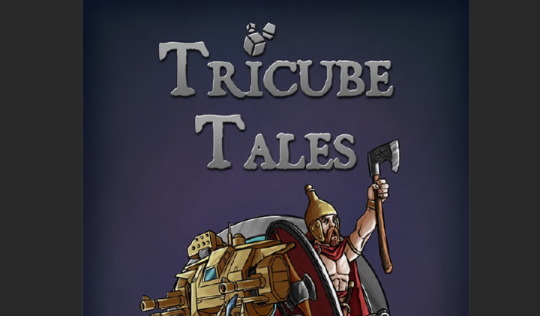R.E. Davis (he/him) / Author, Father, Husband, Geek. Header Art by Luis F Sanz
Don't wanna be here? Send us removal request.
Text
So I've taken a vow to move my RPG reviews/rambles to my Tumblr, and I'm willing to bet someone after this week might be in the market for some new indie fantasy RPG -- especially one that isn't using the OGL. So let me tell you about EYES BEYOND THE TORCHLIGHT!
Disclaimer: I originally reviewed this on Twitter months ago,and have decided to put it all together here in support of this game I love.
SUMMARY:
It's a fantasy heartbreaker. It has 4 archetypes (Cleric, Mage, Rogue & Warrior) and familiar fantasy ancestries (Dwarf, Elf, Gnome, Halfling, Half-Elf, Half-Orc, and Human). It has dungeons, dragons, & themes that will surprise nobody. But it's the approach to game mechanics I've been enjoying.

The core mechanic is d20+Stat vs 12. The catch is that stats are rated in dice, from d4 to d12. There also "Boosts" and "Setbacks" that add or subtract d6s to the total. The system is player facing, with some fun twists.
For example: on successful attack rolls, the value of the Stat Die determines the amount of damage dealt to the target. On unsuccessful defense rolls, your Stat die determines how much damage is soaked (on successful defense rolls, you dodge completely). Enemies have flat damage values -- this is all one roll and go.
Character Creation is fun and flexible. It doesn't inundate a newcomer with too many choices, but it gives a lot of room to build on a theme. Your choice of ancestry and archetype provides starting Edges, and you can choose to gain extras by taking on Hindrances.
Edges & Hindrances are pretty straight forward. They give boosts (or setbacks), raise (or lower) a Stat Die in a situation, or establish a factoid feature or flaw in the narrative. These are all interesting choices, and not "build theory" number tweaks like feats in DND.
I should also note here: there's only 4 stats (Brawn, Agility, Intellect, Presence) and some derivatives (Hit Points, Armor, Initiative & Movement). Oh, and there's HERO POINTS! (Your luck/cool point meta-currency that lets you re-roll or do cool things).
Then there's Backgrounds. Your Background actually functions as your "skill" set -- any non-combat roll associated with it gets a Boost.
Let's talk a bit about what there's not -- NO LEVELS! At least, not proper (there are "tiers" of characters). At the end of every adventure, you get Advancement points. You spend these to raise stats, buy off hindrances or acquire edges. The character progression is pretty open.
One of my players was an Ugly Dwarf Pirate, whose punching attacks deal lethal damage. His companion is a Half-Elf Warrior Poet, who can shapeshift into small animals. Tell me that doesn't sound badass out the gate!
The game also has a pretty complete bestiary of traditional fantasy game monsters, although it skimps details and expects you to already be familiar with them from other games. But hey: stat blocks for them fit on a notecard, which is my most desired aspect as a GM!

I should mention that every monster is listed with a "Threat Number" -- this is the penalty to actions opposing them. You have two choices: add the Threat to the base 12 target number or subtract it from a player's roll instead (whichever is easier).
Now let's talk POWERS -- aka magic. Powers are spells, and once you learn one you keep it. You roll dice when you cast; should you fail you have the option to either take damage OR "burn" the spell to cast it (can't cast it again until you rest).
There's a good list of Powers here, but not a crazy tome like other fantasy games have. Most are utility, with a few combat-based ones. Your token Area of Effect spell "Blast" is dangerous -- it targets EVERYTHING in an area. Fire it off in a mine you risk a cave in.

Blast and other spells also have consequences should you roll 1's on both the d20 and your Stat Die. In this case: your caster *literally explodes and dies* while also harming nearby people. Thankfully not all powers are this risky!
Anyway, plenty of treasure and magical items provided in these rules as well. Anyone can pick up a scroll or potion as a single-use power. There's your usual magical arms and armor, rings that do cool things like teleport you, grant 3 wishes, command elementals etc.
Finally, the rules come with a sample setting and adventure. The setting is a free city on the borderlands between warring nations, with ruins and monsters about. Again, not breaking any molds, but it's pretty cool and has a lot of loose hooks to build a campaign on.

So, to wrap this up: EYES BEYOND THE TORCHLIGHT is RPG comfort food to me. I love the dice mechanics, and how easy it is to hack new content into it. Flexible & interesting player facing mechanics means it's easy to run online. It has old-school vibes without the baggage. Scott Myer wrote and illustrated this game, and now it's in the hands of the folks at MAX HP who seem to be pretty cool as well. PS -- there's an SRD for the Target 12 System that it's built on, and released under Creative Commons.
10 notes
·
View notes
Text
I said I was going to do Dungeon23... INSTEAD, I finished this project and started some others. Anyway, yeah, self-promo incoming: This is the first issue of a zine I'm putting out to supplement my game, SIGIL & SHADOW. We're kicking things off with errata & rules clarifications (yay, I guess). BUT it's also packed with quick references to core mechanics, combat, my magic system and more. It literally serves as a GM Screen, except you print it out as a booklet at home. It's PWYW (including free). Any money tossed towards it will help offset any art or caffeine that goes into the next one.
1 note
·
View note
Text
Thoughts on #Dungeon23
Definitely going to try it. I have so many damn notebooks laying around I really should do SOMETHING with them.
Since this whole thing was Sean McCoy's idea, and because I've had some grim "industrial sci-fi" on the mind, I'm not really plotting a "megadungeon" so much as a giant location crawl for Mothership. An abandoned way station and site of a major archaeological dig involving alien ruins... What's the worst that could happen?
Also: this gives me something to write about regularly on here 😃

3 notes
·
View notes
Text
OOPS, went quiet
i didn't abandon my Tumblr! Just holidays, family life, and keeping my nose on the grindstone has kept me quiet. So have an update!
Echoed Invocations is a "supplemental zine for Sigil & Shadow". Currently wrapping up Issue: 0, which is just a quick rules reference with clarifications/errata. I like to think of it as a GM screen, except it's a booklet you can print out and shove in your book.
I'm also already beginning to write articles for Issue 1, which will be a hodge-podge of optional mechanics. Hope to start dropping these in the new year!

2 notes
·
View notes
Text
Sigil & Shadow is one of many titles on the Osprey Games' Black Friday sale -- 30% off hardcovers, 40% off eBooks (PDF or ePub).
2 notes
·
View notes
Text
Sigil & Shadow, my rpg of Urban Fantasy & Occult Horror, now has a dedicated Discord community.
1 note
·
View note
Text

So my Calendar app has informed me that today, November 18th, is "Occult Day".
Best info I can find on it said back in 2000-2001, newspapers recorded the holiday but other than that? No idea who or when it started. Which I think is deliciously appropriate.
Happy Occult Day to my weirdos. The strange in me sees the strange in you.
3 notes
·
View notes
Text
SHROOM GOONS. Little Mushroom Folk on Big Adventures. Completely free, powered by Tunnel Goons. Artwork by Skullfungus. Just need some six-sided dice, writing utensils, some weird friends and your imagination.
6 notes
·
View notes
Text
This book is amazing, OK? @highlandparanormalsociety already does glorious things with their indie RPGs. This compiles a lot of Nate's big hitters (some lite RPGs, some settings and adventures, some weird game involving wide hats and feathers), gives them some fresh layouts and sticks it in a book that has "new book smell" AND invokes feelings of something old found in the library.
My hope is someday, my son or grandchildren pull it off the shelf and ask "Is this a story?" and I'll smile and say "It's MANY STORIES!" and when they ask to read it I'll say "Oh no... we tell these together!"
And then I'll TPK them in Tunnel Goons.

Only 23 copies of my book left at Games Omnivorous!
22 notes
·
View notes
Text
VIEJA ESCUELA

There's a lot of cool minimalist and “OSR-Adjacent” D&D clones out there. Black Hack, Into the Odd, and Knave are a few of the titles many talk about.
But the one that stole my heart is a little title named Vieja Escuela, a Spanish RPG that had been translated to several languages (including English). The name itself means “Old School” — it’s a set of rules born out of a fanzine of the same name. It has roots in several clones, including Microlite20, Swords & Wizardry, and Whitehack.
What’s The Deal?
First off, the size: 16 pages, including a character sheet and the OGL. It’s the perfect zine-sized rules, and it covers quite a bit. It’s surprisingly detailed, albeit compact. It doesn’t bog you down with fluff or tutorials — it assumes you know the type of game it is, and jumps right into it.
Character creation is the standard rolling 3d6 for the six attributes we all know, with modifiers ranging from -2 to +2. Four races (Human, Elf, Dwarf & Halfling) and three classes (Fighter, Rogue, Magic-User). Every race and class gives you two talents. You also choose a Background (in a 1-sentence description) and then choose four of 6 skills: alertness, communication, lore, manipulation, stealth and survival.
The skills presented here are an interesting twist — modern players of d20/3e and newer will probably scoff at how few there are. OSR types may scoff they’re even in there. Their execution in the rules is even more intriguing: it’s not Stat+Skill, instead they’re chosen over an attribute. On top of that, attribute scores remain static (at least in terms of character advancement) while skills improve over time. The creators stated that they felt experience is more important than attributes, which I can’t really argue with that presentation.
You may have noticed that there’s no Cleric class. There are two reasons for this: First, it’s a game with an implied sword & sorcery vibe — magic is dangerous, and the gods are pretty absent. The other reason is because of the magic system itself. It’s a freeform system, inspired by Whitehack, with a pretty simple-yet-effective guideline attached to it. In short: the Magic-User has a number of Magic Points available per level. When they cast a spell, they must “name it” to give it form. You then haggle with the GM about how many points the effect will cost. The guideline mentioned is 1 Point = 1d6 Damage or Healing, or a level of effect. For bigger effects the GM may also put in other sacrifices: health, money, stats, etc. Matter of fact it should be noted that a Magic-User can sacrifice 3 Hit Points for 1 point of Magic.
Running the Game
The mechanics of the game are roll high on a d20, adding modifiers, usually against a difficulty number. The lowest difficulty is 11+, for standard or hurried tasks (if it’s easy, the game asks, why roll?). After that the difficulty escalates by 3 (14, 17, and 20+). There is a 5e “Advantage/Disadvantage” system present as well.
Combat uses rolls against an ascending Defense score, modified by ability scores and an attack bonus by level. “Saving Throws” here are rolled vs Difficulty using a combined bonus of Ability Modifiers and an “Instincts” score. I would love to point out that Wisdom functions as a “Sanity” score in this system, and there are even times to make a Charisma roll in this system! (Primarily for attuning magical items.)
On tasks, as I’ve mentioned, the player uses either an ability score or a skill. If their Background would offer experience in dealing with the task, they get a +2. If it’s deeply connected to their Background, they get to roll with Advantage. I LOVE THIS. At first I was worried the skills and attribute modifiers were too small, but working within your background concept offsets the odds and makes even simple Level 1 characters playable and somewhat competent.
Monsters are short, sweet little stat blocks. Their Level determines their Hit Dice, Attack Bonus, and their Instincts score. This makes it incredibly easy to arbitrate NPCs and new monsters on the fly. Should also be pretty easy to convert most OSR stat blocks by just focusing on their level and any important attacks or features.
Magical items are pretty straight forward — anyone can use potions, magic-users and thieves can read magic scrolls. Enchanted items, however, are sought after but also risky — especially since most of these items are considered to be intelligent (we have an example of a sentient sword that will fight on its own, but if its own avoids combat it may turn on them!)
Characters level at the same rates, and the game is presented on a B/X-style scale of 1-14. At level 6 you acquire a third talent for your class (Fighters get a better crit range, MUs get a familiar, and Rogues can use magic scrolls.) At 10th level, you get a new background, but this one is tied to a title of importance — Baron of a Region, Leader of the Thieves Guild, Archmage of the Tower, etc.
The XP system itself is swift: Every session the GM awards 1-3 XP. At 10 XP, you level. It’s easy, it allows the GM to set the pace or the rewards, it’s not dependent on slaying monsters or acquiring treasure, and it’s a bit more detailed than leveling up after every adventure or milestone arbitrated by the GM.
My Take Aways
As time goes on, I realize just how elegant and thought out the rules are. It’s a very nice middle ground of old-school and modern gaming ideas. Where I was initially concerned that it was too simple, and that characters would play too similarly, I realize there’s plenty of wiggle room for players and DMs to tinker without having to really add new rules.
The free-form casting may be tricky for some players or GMs but I find it pretty liberating, especially since it’ll still play nice with most OSR content. I’ve actually printed Maze Rats spell generation tables, as well as Knave’s 100 Level-less spells to keep for inspiration and ideas (and also to randomly produces scrolls for players to find.)
While I tend to groove the options and “fullness” of games like D&D Rules Cyclopedia or Swords & Wizardry Complete, VE hits all the right notes for me — it has enough familiar mechanics that players of both old-school and modern can pick up. The number ranges are easy to track, and monster stat blocks can fit on a post-it note. The generalized skills and Background mechanics make it easy to make a variety of characters. The free-form magic system is simple, infinite but reeled-in. Easy to add on to and plays nice with other OSR games. And, most importantly: I can pack this whole game up and take it anywhere no problem!
FIND VIEJA ESCUELA HERE:
Vieja Escuela main zine site (in Spanish)
English Translation of the Game
Lulu POD Copy
Also, if you want something more compact than a zine, I made a Pamphlet Version!
8 notes
·
View notes
Text
TRICUBE TALES

I'm going to start moving (and updating) reviews from my website, and today I wanted to start with a rules-lite system that packs a surprising amount of punch: Tricube Tales by Richard Woolcock of Zadmar’s Games. There’s a lot I want to say about it, which is crazy because it’s also pretty lite and simple. Also, the damn game is free (full thing in the DTRPG preview) so you can easily check it for yourself.
I’ll keep this brief: Tricube Tales is a minimalist, lite RPG using a mechanic where you roll 1 to 3 six-sided dice, and if any of them hit the target number you succeed. It uses fluctuating difficulty (a base scale of 4, 5, and 6) and Players make all the rolls. This makes it a great system for solo gaming and asynchronous play-by-chat games over Discord.
Character creation is very straight forward, appearing almost too simple but there is weight for it. Here’s what a playable character looks like at a glance:
Sam Strongblade, a Brawny Dwarf Soldier Perks: Dwarf Stamina Quirks: Wooden Peg-Leg Karma: 3 / Resolve: 3
That’s it. You can glance at that, have an idea of what the character does, and maybe dismiss the fact that there’s no stats (Karma and Resolve are point pools, which I’ll explain in a bit.)
That first statement is your archetype, which includes a trait (Agile, Brawny or Crafty) and a concept. Your archetype will help determine if you’re rolling two or three dice (or 1 if it has nothing in common with the action being performed). Your Perks establish special qualities, powers, abilities or unique equipment. Often you can spend a Karma point to use a perk significantly in an action (such as lowering the difficulty). Quirks, likewise, can hinder the character. A player can actively choose to work their Quirk into the narrative, taking a penalty but in doing so restores 1 Karma.
So, if you haven’t guessed yet, Karma is the luck/fortune/power pool that lets the players do cool things. Resolve is the stress/health/endurance pool for every character. When a character hits 0 resolve, they’re taken out of the conflict, and the victor (either PC or GM) gets to narrate what happens. When this happens to player characters, they return next scene, their Resolve restored but now with an Affliction — usually a temporary quirk, but sometimes these can become more serious. Character death isn’t off the table as long as GM and Players agree to the arbitration.
Running things on the GM side is pretty easy-peasy. Most challenges are static pass-or-fail; more elaborate obstacles or tasks are assigned a pool of Effort tokens (where each successful die roll against it removes a token). Combat encounters can track multiple foes separately or you can just say “a horde of goblins” and track a single pool of effort tokens.
There’s a lot more going on — the game covers some quick ground on genre rules, like handling cybernetics, fear, magic & psionics, varying power levels, superheroes and vehicles. For the most part, all of these are just common-sense guides for arbitrating things based on context. This may be the deal breaker for some — this is a game system where players and the GM should be comfortable going back and forth making their own judgment calls on how things go down. It’s pretty much “Roll the dice, and if you succeed — narrate what happens.” It was a system originally designed with kids in mind, but obviously it has appeal to older gamers as well.
I love the damn thing. I’ve played solo games with it, and even made a pocketfold game based on it.
Definitely check it out, and if you dig it — toss the guy a couples bucks. Buying the game gets you a PDF scaled for tablet/PC use as well as a Word doc so you can hack it and make your own stuff with it.
2 notes
·
View notes
Text

Artwork by Luis F Sanz.
From my RPG, Sigil & Shadow, published by Osprey Games.
2 notes
·
View notes
Text
I'm seeing posts about chasing off the Twitter refugees and I just want to say...
I was here at the peak of Supernatural fandom. So much Sherlock slash fic. Don't even get me started on the erotic Hannibal gif posting. Y'all are cute.

#Is spilled ink still a thing?#Y'all gonna make Castiel weep#I've seen cringe you people wouldn't believe
2 notes
·
View notes
Text

Putting this intent out there, as a sort of an early 2023 Gamer Resolution: When friends pressure me to run D&D in any flavor, I'll fucking run Vaults of Vaarn. It's such an evocative setting -- you want weird sci-fantasy? This is the good stuff. It's the right balance of gonzo, mysterious, silly in place and grim in others. So many lush tables, such macabre encounters. Leo Hunt has written one of my favorite "dying world" games. Check it out for yourself.
21 notes
·
View notes
Text
My latest post is a quick primer of my own Sigil & Shadow campaign. Dive into the murky markets of Houston's occult underground!
0 notes
Text

Hello, again.
I'm R.E. Davis. I like to write about my nerdy interests -- in particular table-top rpgs, vidiot games, music and more. I have a particular fondness for the spooky, strange and weird. I tend dwell in the liminal space between modern occult fantasy and cybernetic dystopia.
I've written some games! My biggest one being SIGIL & SHADOW -- A Role-Playing Game of Urban Fantasy & Occult Horror. I've also self-published some indie stuff that you can find on Itch.
You can find out more about all of these on my website https://chaosgrenade.com
Going forward, I want to use Tumblr as a relaxed place to ramble about my favorite hobbies. Please feel free to follow or ask me anything!
2 notes
·
View notes